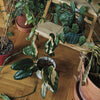How to grow an Olive Tree
Do you want to start growing a plant that can be both a challenge and a great reward? Get an olive tree! This Mediterranean tree can be a great addition to your home jungle, but it requires specific care to really thrive. In this article, we have written the necessary information and tips on how to care for an olive tree so that it will decorate your home for many years.

A bit of history to start:
The olive tree ( Olea europaea ) is one of the oldest cultivated trees in the world and its origins date back thousands of years. Historically speaking, olive trees were domesticated in the Mediterranean area approximately 6,000 years ago, with the first records of their cultivation coming from ancient Egypt.
Ancient civilizations
In ancient Greece, the olive tree was of fundamental cultural and economic importance. It was a symbol of peace and prosperity, and olives and their oil had an important place in the daily diet, religious ceremonies and as a source of illumination. Greek legends often refer to the olive tree, the most famous being the story where the goddess Athena gives the olive tree to the people of Athens as a gift, bringing wealth and victory to the city.
In ancient Rome, the olive tree was also highly valued and its cultivation spread throughout the empire, especially in the areas that are now Italy, Spain and North Africa. The Romans improved olive processing methods and expanded the trade in olive oil.
Middle Ages and Modern Ages
During the Middle Ages, the tradition of growing olives was maintained mainly in monastery gardens and on the estates of the nobility. During the Renaissance, olive growing and processing techniques were further developed.
Modern times
In modern times, olive trees are cultivated in large parts of the world, especially in countries with suitable climates such as Spain, Italy, Greece, Turkey, California and Australia. Olive oil is now globally valued for its health benefits and gastronomic value.

The olive tree thus represents an important element of the cultural heritage and agricultural history of many nations, and its story is closely linked to the history of human civilization. Its longevity and ability to thrive in challenging conditions make the olive tree a symbol of resilience and renewal.
With its narrow, grey-green leaves and bright stems, this tree will appeal to anyone looking for a simple and elegant decoration. Although there are many types of olive trees, the most suitable for indoor cultivation is the dwarf olive tree Olea europea, which does not reach a height of more than 180 cm (but can of course reach slightly larger dimensions), unlike other species that can grow up to 9 meters.

Caring for the Olive Tree
Olive trees are light-loving plants. They thrive in very bright conditions with direct sunlight, which they should ideally have 6-8 hours a day. Since the average household often cannot provide enough natural light, it is advisable to place the olive tree near a south-facing window to get as much light as possible. In periods with shorter daylight, you can supplement the plant with artificial lighting.
Air and temperature
The olive tree prefers a warm and dry environment that mimics its natural Mediterranean environment. The plant benefits from good air circulation, so it is important to ensure that the place where the olive tree stands is not closed and allows for sufficient air flow. Unlike Ficus, he likes it! During the summer months, it is ideal to move the plant outside, where it will enjoy the fresh air.
Topping and moisture
Although the olive tree requires less water than many other plants, it is important to keep its soil slightly moist. Watering should be regular but moderate - always let the topsoil dry out between waterings. In winter, when the plant grows more slowly, reduce the frequency of watering. The plant also does not like excessive humidity, so it feels good in indoor spaces with central heating.
Transplanting and fertilizing
Olive trees grow relatively slowly, so there is no need to transplant them often. It is recommended to check every two to three years whether the roots do not fill the entire pot and, if necessary, transplant the plant into a larger one.
For the olive tree, it is best to use a well-draining substrate that mimics its natural dry and stony environment. An ideal mix might include:
- Succulent substrate that is specially formulated for succulents and cacti that is well drained
- Perlite to improve drainage and soil structure
Fertilization is important to maintain the health and vitality of the olive tree, especially during the period of active growth in spring and summer. Use a fertilizer formulated for Mediterranean plants or a general houseplant fertilizer with a balanced NPK (Nitrogen, Phosphorus, Potassium) ratio. Apply the fertilizer according to package directions, but be careful not to over-fertilize, which could damage the plant.
Fertilization rules
- Fertilize approximately once a month during the growing season.
- In the winter months, when the plant enters a period of rest, reduce or stop fertilizing completely, because the plant does not use nutrients much at this time and rather rests
Care at the end of the season
As already mentioned, the olive tree should spend part of the year outside. At the end of summer, before temperatures start to drop below 10 degrees Celsius, the plant should be moved back inside. This transition should be gradual to allow the plant to acclimate to the change in environment.
Toxicity
Olive trees are harmless to pets and humans when ingested! While it's generally recommended that animals and children don't try to eat any houseplants, you can feel safe having these beauties in your home in case someone fancies a "snack."

Common pests and problems
Caring for olive trees may be simple, but there are problems that can afflict this plant. The main step in care is proper lighting, given their high demands on light, but it is also important to pay attention to the following problems:
Puckles
If you notice sticky spots and brown "lumps" along the stems, these may be canker sores. Damage includes yellowing and damage to leaves (old and new) with unhealthy new growth. Remove any buds with a soft cloth soaked in alcohol and then treat the entire plant with Substral, repeating this treatment every 10 days until all signs of pests have disappeared. Check the underside of the leaves regularly.
Ripples
Have you ever noticed white clumps appearing on some of your plants? Or waxy secretions on the underside of some leaves? Have the leaves of any of your plants ever started turning yellow and wilting without explanation? If so, they are probably infested with worms.
Some species (yes, you read that right, there are multiple types of worms) feed on plant roots, others are found in the nooks and crannies of the plant, such as where the leaf meets the stem, on the underside of the leaf, or in any other hidden place they can find. This is one of the reasons why they are so difficult to eradicate - just when you think you've got rid of them all, more usually appear.
How to get rid of worms
Since worms are quite difficult to get rid of once you find them, repeat this process several times to make sure you get rid of each one:
Remove heavily infested leaves from the plant (unfortunately, they won't be prettier and take unnecessary energy from the plant) and you will most likely get rid of a large part of the worms that have taken up residence with you. Dip a cotton swab in rubbing alcohol/spirits and dab it on any worm bodies you see, which should kill them on the spot. Then wash the plant with water and rinse off the remains of the worms.
Leaf fall:
This problem can be the result of many factors, including the following:- Watering issues: Watch out for too dry or too wet soil, follow our watering guidelines above.
- Insufficient light: Olive trees require a lot of light, unfortunately they will not survive in dimly lit areas.
- Lack of nutrients: Like most living things, olive trees need enough nutrients.
- Root rot: This problem occurs if overwatering occurs, so make sure the plant is watered according to our recommendations.
- Transition Stress: Like citrus trees, olive trees go through a period of adaptation as they get used to their new home environment, so give them time and make sure all conditions are ideal for their needs.
If you feel like you want to make life a little more pleasant for your plant, shower it once a month, wash all the leaves (tops and bottoms) and stems, and water the soil at the same time. This will remove any pests as well as dust or dirt.
This care will ensure that your olive tree will grow beautifully and be healthy, whether you grow it indoors or outdoors.
We hope that our article has helped you get a clearer idea of how to care for an olive tree and that you will be able to grow this charming plant successfully. With enough knowledge and patience, an olive tree can become not only a beautiful, but also a durable addition to your home. Remember that each olive tree may require an individual approach depending on your environment. We wish you much success and joy in growing your olive tree!

-
Posted in
Péče o pokojovky




